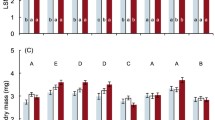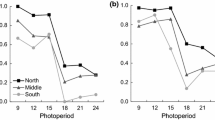Abstract
Successful latitudinal expansions into temperate climates depend largely upon the evolution of novel adaptive traits or the presence of pre-adaptive or exapted mechanisms for survival in seasonal climates. Geographic comparisons of ancestral (pre-expansion) and derived (post-expansion) populations provide a useful framework for understanding the evolutionary conditions that facilitate geographic expansions. Using a common agricultural pest, the Colorado Potato Beetle, Leptinotarsa decemlineata Say (Coleoptera: Chrysomelidae) as a model, we conducted a regional comparison of cold hardiness and overwintering success among ancestral (southern Mexico) and derived (Vermont and Kansas, USA) L. decemlineata populations. In order to determine if ancestral and derived beetle populations vary physiologically for cold hardiness, we compared supercooling points (SCPs) of three geographic populations of L. decemlineata. We also tested if ancestral and derived beetle populations differed in their overwintering behavior and success by performing an overwintering field experiment. Ancestral and derived populations did not express different physiological responses (i.e. SCPs) to freezing temperatures. However, ancestral and derived populations responded differently to the onset of winter conditions and displayed dissimilar overwintering behaviors. The majority of ancestral beetles failed to initiate diapause and dug upward within experimental mesocosms. Differences in overwintering behavior also resulted in significant variation in overwintering success as derived populations displayed higher overwintering survivorship when compared with ancestral populations. Given our results, it is evident that research exploring the interaction of the ecological factors and evolutionary processes is necessary to fully realize the dynamics of biological invasions.





Similar content being viewed by others
References
Alyokhin A, Baker M, Mota-Sanchez D, Dively G, Grafius E (2008) Colorado potato beetle resistance to insecticides. Am J Potato Res 85:395–413
Baker MB, Alyokhin A, Porter AH, Ferro DN, Dastur SR, Galal N (2007) Persistence and inheritance of costs of resistance to imidacloprid in Colorado potato beetle. J Econ Entomol 100:1871–1879
Bale JS (2002) Insects and low temperatures: from molecular biology to distributions and abundance. Philos Trans R Soc Lond B Biol Sci 357:849–862
Bale JS, Hayward SAL (2010) Insect overwintering in a changing climate. J Exp Biol 213:980–994
Boiteau G, Coleman W (1996) Cold tolerance in the Colorado potato beetle, Leptinotarsa decemlineata (Say) (Coleoptera: Chrysomelidae). Can Entomol 128:1087–1099
Bradshaw WE, Holzapfel CM (2007) Evolution of animal photoperiodism. Annu Rev Ecol Evol Syst 38:1–25
Cappaert DL (1988) Ecology of the Colorado potato beetle in Mexico. Michigan State University, East Lansing, MI, Dissertati
Casagrande RA (1987) The Colorado potato beetle 125 years of mismanagement. Bull Entomol Soc Am 33:142–150
Danks HV (2002) Modification of adverse conditions by insects. Oikos 99:10–24
Danks HV (2004) Seasonal adaptations in arctic insects. Integr Comp Biol 44:85–94
Denlinger DL (2002) Regulation of diapause. Annu Rev Entomol 47:93
Denlinger DL, Lee RE (2010) Low temperature biology of insects. Cambridge University Press, Cambridge
Dhondt AA (1997) Synchronization of hatching date with budburst of individual host trees (Quercus robur) in the winter moth (Operophtera brumata) and its fitness consequences. J Anim Ecol 66:113
Diaz MDC, Peck DC (2007) Overwintering of annual bluegrass weevils, Listronotus maculicollis, in the golf course landscape. Entomol Exp Appl 125:259–268
Dingle H (2001) The evolution of migratory syndromes in insects. Insect Movement: Mechanisms and Consequences, p 159–181
Duman JG, Wu DW, Xu L, Tursman D, Olsen TM (1991) Adaptations of insects to subzero temperatures. Q Rev Biol 66:387–410
Follett PA, Roderick GK (1996) Adaptation to insecticides in Colorado potato beetle: Single- and meta-population models. SPB Academic Publishing, Amersterdam, Netherlands
Gaston KJ (2003) The how and why of biodiversity. Nature 421:900–901
Gatehouse VAD and AG (1995) Insect Migration. Cambridge University Press: Cambridge
Guillemaud T, Ciosi M, Lombaert E, Estoup A (2011) Biological invasions in agricultural settings: insights from evolutionary biology and population genetics. CR Biol 334:237–246
Haack RA, Lawrence RK, Heaton GC (2001) Tomicus piniperda (Coleoptera: Scolytidae) shoot-feeding characteristics and overwintering behavior in scotch pine Christmas trees. J Econ Entomol 94:422–429
Hare JD (1990) Ecology and management of the Colorado potato beetle. Annu Rev Entomol 35:81–100
Hiiesaar K, Kuusik A, Joudu J, Metspalu L, Hermann P (2001) Laboratory experiments on cold acclimation in overwintering Colorado potato beetles, Leptinotarsa decemlineata (Say). Nor J Entomol 48:87–90
Hiiesaar K, Metspalu L, Jõudu J, Jõgar K (2006) Over-wintering of the Colorado potato beetle (Leptinotarsa decemlineata Say) in field conditions and factors affecting its population density in Estonia. Agronomy Res 4:21–30
Hochachka P, Somero G (2002) Biochemical adaptation: mechanism and process in physiological evolution, vol 480. Oxford University Press, New York
Hoffmann AA, Sørensen JG, Loeschcke V (2003) Adaptation of drosophila to temperature extremes: bringing together quantitative and molecular approaches. J Therm Biol 28:175–216
Hsiao TH (1981) Ecophysiological adaptations among geographic populations of the Colorado potato beetle in North America. in Advances in Potato Management, p 69–85
Hsiao TH (1982) Inheritance of three autosomal mutations in the Colorado potato beetle, Leptinotarsa Decemlinieata (Coleoptera:Chrysomeldiae). Genome 24:681–686
Hunt DWA, Tan CS (2000) Overwintering densities and survival of the Colorado potato beetle (Coleoptera: Chrysomelidae) in and around tomato (Solanaceae) fields. Can Entomol 132:103–105
Jacobson J, Hsiao TH (1983) Isozyme variation between geographic populations of the Colorado potato beetle, Leptinotarsa decemlineata (Coleoptera: Chrysomelidae). Ann Entomol Soc Am 76:162–166
Jacques RL (1988) The Potato Beetles: The Genus Leptinotarsa in North America (Coleoptera: Chrysomelidae). E. J, Brill
Jepsen JU, Kapari L, Hagen SB, Schott T, Vindstad OPL, Nilssen AC, Ims RA (2011) Rapid northwards expansion of a forest insect pest attributed to spring phenology matching with sub-Arctic birch. Glob Change Biol 17:2071–2083. doi:10.1111/j.1365-2486.2010.02370.x
Keane RM, Crawley MJ (2002) Exotic plant invasions and the enemy release hypothesis. Trends Ecol Evol 17:164–170
Kellermann V, van Heerwaarden B, Sgrò CM, Hoffmann AA (2009) Fundamental evolutionary limits in ecological traits drive drosophila species distributions. Science 325:1244–1246
Kimura MT (1988) Adaptations to temperate climates and evolution of overwintering strategies in the drosophila melanogaster species group. Evolution 42:1288–1297
Koch RL, Carrillo MA, Venette RC, Cannon CA, Hutchison WD (2004) Cold hardiness of the multicolored asian lady beetle (Coleoptera: Coccinellidae). Environ Entomol 33:815–822
Kolar CS, Lodge DM (2001) Progress in invasion biology: predicting invaders. Trends Ecol Evol 16:199–204
Kostál V, Simek P (1995) Dynamics of cold hardiness, supercooling and cryoprotectants in diapausing and non-diapausing pupae of the cabbage root fly, Delia radicum L. J Insect Physiol 41:627–634
Lee E (2002) Evolutionary genetics of invasive species. Trends in Ecol Evol 17:386–391
Lefevere K, Kort CAD (1989) Adult diapause in the Colorado potato beetle, Leptinotarsa decemlineata: effects of external factors on maintenance, termination and post-diapause development. Physiol Entomol 14:299–308
Lu W, Logan PA (1993) Induction of feeding on potato in Mexican Leptinotarsa decemlineata (Coleoptera: Chrysomelidae). Environ Entomol 22:759–765
Lu WH, Logan P (1994) Inheritance of larval body color in Leptinotarsa decemlineata (Coleoptera: Chrysomelidae). Ann Entomol Soc Am 87:454–459
Lyytinen A, Lindstrom L, Mappes J (2008) Genetic variation in growth and development time under two selection regimes in Leptinotarsa decemlineata. Entomol Exp Appl 127:157–167
Lyytinen A, Boman S, Grapputo A, Lindström L, Mappes J (2009) Cold tolerance during larval development: effects on the thermal distribution limits of Leptinotarsa decemlineata. Entomol Exp Appl 133:92–99
Nault BA, Hanzlik MW, Kennedy GG (1997) Location and abundance of adult Colorado potato beetles (Coleoptera: Chrysomelidae) following potato harvest. Crop Prot 16:511–518
Nelson RJ, Denlinger DL, Somers DE (2010) Photoperiodism: The Biological Calendar. Oxford University Press, Oxford
Piiroinen S, Ketola T, Lyytinen A, Lindström L (2011) Energy use, diapause behaviour and northern range expansion potential in the invasive Colorado potato beetle. Funct Ecol 25:527–536
Rako L, Hoffmann AA (2006) Complexity of the cold acclimation response in Drosophila melanogaster. J Insect Physiol 52:94–104
Renault D, Salin C, Vannier G, Vernon P (2002) Survival at low temperatures in insects: what is the ecological significance of the supercooling point? Cryo Letters 23:217–228
Salt RW (1961) Principles of insect cold-hardiness. Annu Rev Entomol 6:55–74
Sexton JP, McIntyre PJ, Angert AL, Rice KJ (2010) Evolution and ecology of species range limits. Annu Rev Ecol Evol Syst 40:415–436
Shea K, Chesson P (2002) Community ecology theory as a framework for biological invasions. Trends Ecol Evol 17:170–176
Sinclair BJ, Addo-Bediako A, Chown SL (2003a) Climatic variability and the evolution of insect freeze tolerance. Biol Rev Camb Philos Soc 78:181–195
Sinclair BJ, Vernon P, Jaco Klok C, Chown SL (2003b) Insects at low temperatures: an ecological perspective. Trends Ecol Evol 18:257–262
Sømme L (1982) Supercooling and winter survival in terrestrial arthropods. Comp Biochem Physiol A Physiol 73:519–543
Stastny M, Battisti A, Petrucco-Toffolo E, Schlyter F, Larsson S (2006) Host-plant use in the range expansion of the pine processionary moth, Thaumetopoea pityocampa. Ecol Entomol 31:481–490. doi:10.1111/j.1365-2311.2006.00807.x
Tauber MJ, Tauber CA, Obrycki JJ, Gollands B, Wright RJ (1988) Geographical variation in responses to photoperiod and temperature by Leptinotarsa Decemlineata (Coleoptera, Chrysomelidae) during and after dormancy. Ann Entomol Soc Am 81:764–773
Tower W (1906) Investigation of evolution in chrysomelid beetles of the genus Leptinotarsa. Carnegie Institution of Washington, Washington
Turnock WIJ, Fields P (2005) Winter climates and coldhardiness in terrestrial insects, p 561–576
Weber D (2003) Colorado beetle: pest on the move. Pestic Outlook 14:256
Weber DC, Ferro DN (1993) Distribution of overwintering Colorado potato beetle in and near massachusetts potato fields. Entomol Exp Appl 66:191–196
Zachariassen KE, Kristiansen E, Pedersen SA, Hammel HT (2004) Ice nucleation in solutions and freeze-avoiding insects-homogeneous or heterogeneous? Cryobiology 48:309–321
Zehnder GW, Sandall L, Tisler AM, Powers TO (1992) Mitochondrial-DNA diversity among 17 geographic populations of Leptinotarsa Decemlineata (Coleoptera Chrysomelidae). Ann Entomol Soc Am 85:234–240
Zhou Z-S, Guo J-Y, Michaud JP, Li M, Wan F-H (2011) Variation in cold hardiness among geographic populations of the ragweed beetle, Ophraella communa LeSage (Coleoptera: Chrysomelidae), a biological control agent of Ambrosia artemisiifolia L. (Asterales: Asteraceae), in China. Biol Invasions 13:659–667
Acknowledgments
We would like to thank Jordan Armstrong for his technical assistance during the rearing of L. decemlineata populations and the University of Vermont Greenhouse Management Staff, especially Tom Doubleday, Dave Heleba and Colleen Armstrong for their experimental support. Furthermore, we would like to extend our gratitude to the late Scott Costa for the use of his supercooling equipment and support during the execution of the study. We are also grateful to Scott Lewins for his counsel during the length of the study and his review of the manuscript. We would also like to thank Liz Saccardi for her editorial comments. Finally we want to thank Charles Goodnight, Deborah Neher and Alison Brody of the University Vermont for their support and advisory roles during this project.
Author information
Authors and Affiliations
Corresponding author
Rights and permissions
About this article
Cite this article
Izzo, V.M., Hawthorne, D.J. & Chen, Y.H. Geographic variation in winter hardiness of a common agricultural pest, Leptinotarsa decemlineata, the Colorado potato beetle. Evol Ecol 28, 505–520 (2014). https://doi.org/10.1007/s10682-013-9681-8
Received:
Accepted:
Published:
Issue Date:
DOI: https://doi.org/10.1007/s10682-013-9681-8




